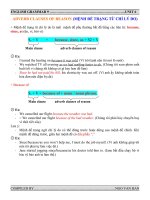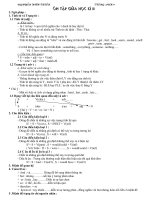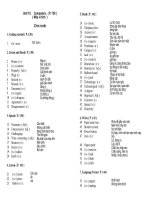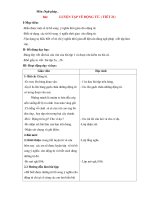- Trang chủ >>
- Đề thi >>
- Đề thi lớp 9
Ngu phap bai 6 nondefining relative clause
Bạn đang xem bản rút gọn của tài liệu. Xem và tải ngay bản đầy đủ của tài liệu tại đây (49.12 KB, 2 trang )
<span class='text_page_counter'>(1)</span><div class='page_container' data-page=1>
<b>NON-DEFINING RELATIVE CLAUSE</b>
<b>Definition: A non-defining relative clause (also called non-identifying relative clauses or non-restrictive </b>
<i><b>relative clauses) provide interesting ADDITIONAL information which is not essential to understanding the meaning of</b></i>
the sentence. It tells us more about someone or something, but do not define it.
<i>Elephants, which are large and grey, can sometimes be found in zoos.</i>
<i>* This gives us some extra information about elephants - we are talking about all elephants, not just one type</i>
<i>or group.</i>
<i>My sister, who lives in France, is coming to stay with me next week.</i>
<i>* "who lives in France" is not essential, which means that I only have one sister and she does not need to be </i>
<i>defined by the "relative clause")</i>
<b>Punctuation Correct punctuation is essential in non-defining relative clauses. If the non-defining relative clause </b>
occurs in the middle of a sentence, a comma is put before the relative pronoun and at the end of the clause. If the
non-defining relative clause occurs at the end of a sentence, a comma is put before the relative pronoun.
<i>My friend John, who went to the same school as me, has just written a best-selling novel.</i><b>Relative pronouns: The following relative pronouns are used in non-defining clauses:</b>
Person Thing Place
Subject who which
Object who/whom which where
Possessive whose
<b>Notes:</b>
In non-defining clauses, you cannot use "that" instead of "who", "whom" or "which".
You cannot leave out the relative pronoun, even when it is the object of the verb in the relative clause:
<i>He gave me the letter, which was in a blue envelope.</i>
<i>He gave me the letter, which I read immediately.</i>
Non-defining clauses can be introduced by expressions like "all of", "many of" + relative pronoun:
Person Thing
all of + whom + which
any of + whom + which
few of + whom + which
both of + whom + which
each of + whom + which
either of + whom + which
half of + whom + which
many of + whom + which
most of + whom + which
much of + whom + which
none of + whom + which
one of + whom + which
two of etc… + whom + which
</div>
<span class='text_page_counter'>(2)</span><div class='page_container' data-page=2>
The relative pronoun "which" at the beginning of a non-defining relative clause, can refer to all the information
contained in the previous part of the sentence, rather than to just one word.
<i>Chris did really well in his exams, which was a big surprise. </i><i>* = the fact that he did well in his exams was a big surprise.</i>
<i>An elephant and a mouse fell in love, which is most unusual. </i><i>* = the fact that they fell in love is unusual).</i>
<b>Examples:</b>
</div>
<!--links-->









